An Examination of Private Health Insurance in Healthcare Financing
VerifiedAdded on 2022/09/14
|7
|1509
|13
Essay
AI Summary
This essay delves into the evolution and impact of private health insurance within the healthcare financing landscape. It begins by tracing the historical development of private health insurance, highlighting key milestones like the introduction of Blue Cross and Blue Shield plans. The essay then examines the benefits of private health insurance, including consumer protections under federal law such as the right to choose doctors and the 80/20 rule. Furthermore, it explores the emergence of consumer-driven healthcare approaches, empowering individuals to take control of their healthcare costs and decisions. The role of nursing professionals is also discussed, emphasizing their evolving responsibilities in providing care coordination and acting as health risk educators within the private health insurance market. The essay concludes by underscoring the significance of private health insurance in the healthcare system and its implications for both consumers and healthcare providers.
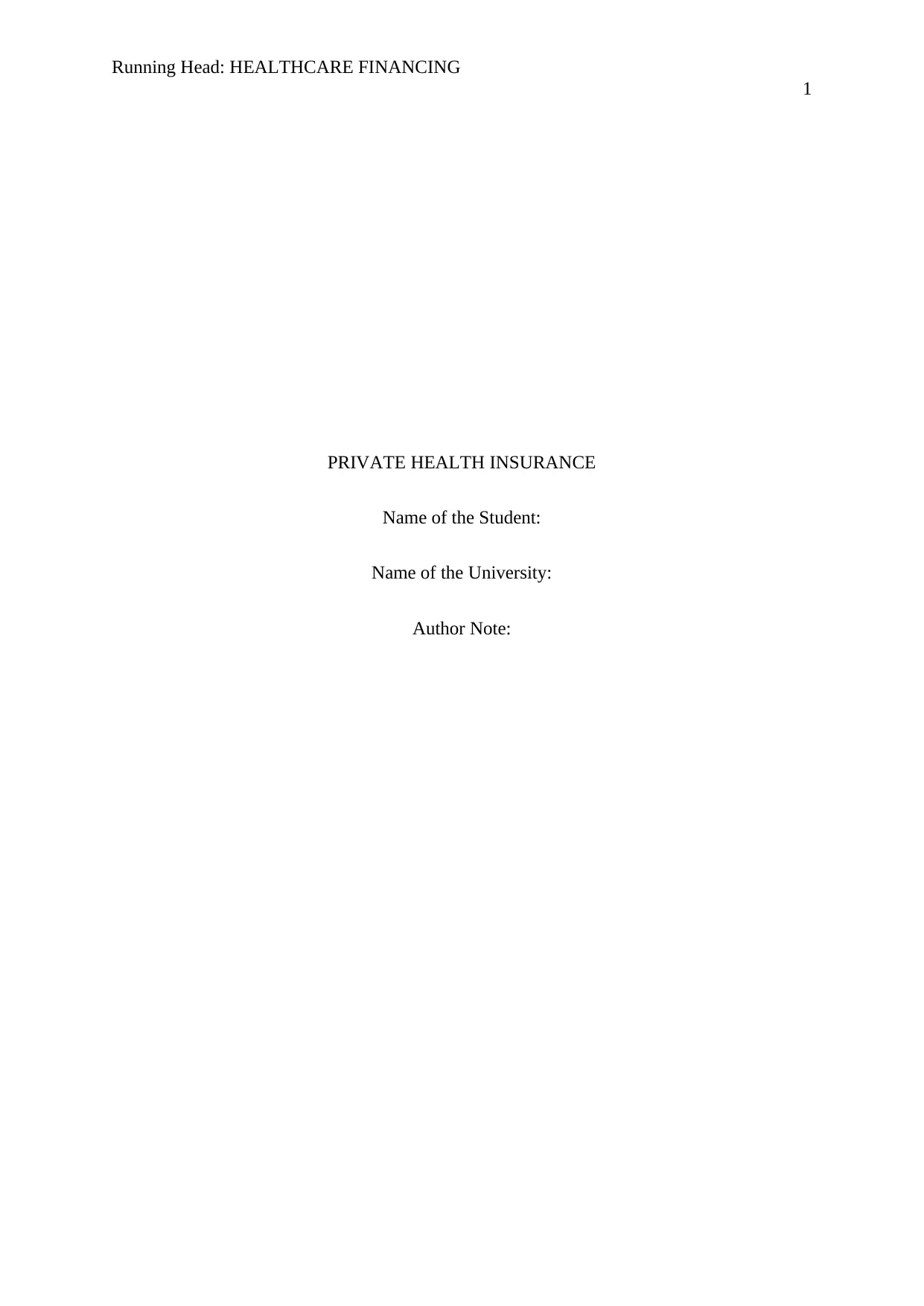
Running Head: HEALTHCARE FINANCING
1
PRIVATE HEALTH INSURANCE
Name of the Student:
Name of the University:
Author Note:
1
PRIVATE HEALTH INSURANCE
Name of the Student:
Name of the University:
Author Note:
Paraphrase This Document
Need a fresh take? Get an instant paraphrase of this document with our AI Paraphraser
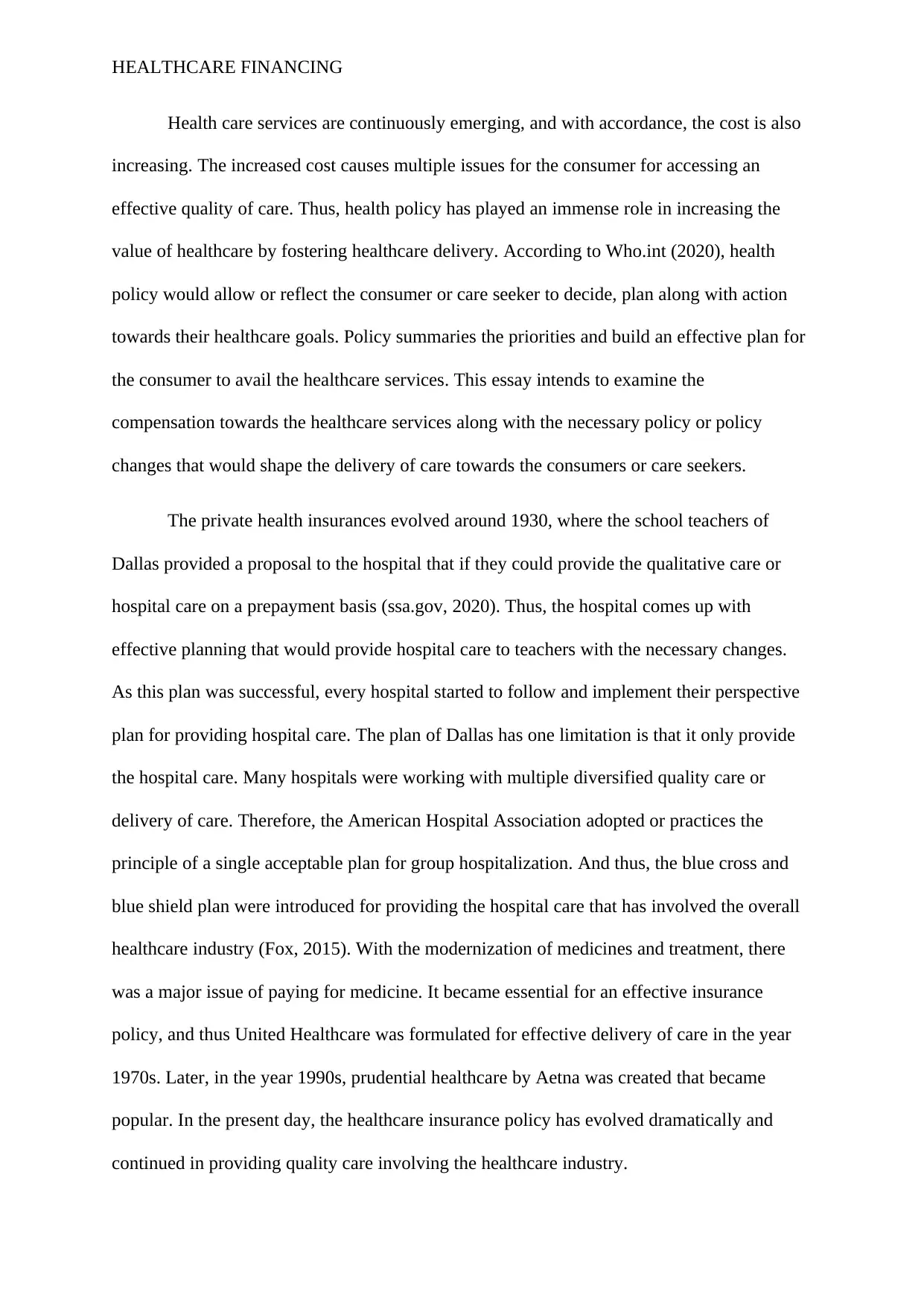
HEALTHCARE FINANCING
Health care services are continuously emerging, and with accordance, the cost is also
increasing. The increased cost causes multiple issues for the consumer for accessing an
effective quality of care. Thus, health policy has played an immense role in increasing the
value of healthcare by fostering healthcare delivery. According to Who.int (2020), health
policy would allow or reflect the consumer or care seeker to decide, plan along with action
towards their healthcare goals. Policy summaries the priorities and build an effective plan for
the consumer to avail the healthcare services. This essay intends to examine the
compensation towards the healthcare services along with the necessary policy or policy
changes that would shape the delivery of care towards the consumers or care seekers.
The private health insurances evolved around 1930, where the school teachers of
Dallas provided a proposal to the hospital that if they could provide the qualitative care or
hospital care on a prepayment basis (ssa.gov, 2020). Thus, the hospital comes up with
effective planning that would provide hospital care to teachers with the necessary changes.
As this plan was successful, every hospital started to follow and implement their perspective
plan for providing hospital care. The plan of Dallas has one limitation is that it only provide
the hospital care. Many hospitals were working with multiple diversified quality care or
delivery of care. Therefore, the American Hospital Association adopted or practices the
principle of a single acceptable plan for group hospitalization. And thus, the blue cross and
blue shield plan were introduced for providing the hospital care that has involved the overall
healthcare industry (Fox, 2015). With the modernization of medicines and treatment, there
was a major issue of paying for medicine. It became essential for an effective insurance
policy, and thus United Healthcare was formulated for effective delivery of care in the year
1970s. Later, in the year 1990s, prudential healthcare by Aetna was created that became
popular. In the present day, the healthcare insurance policy has evolved dramatically and
continued in providing quality care involving the healthcare industry.
Health care services are continuously emerging, and with accordance, the cost is also
increasing. The increased cost causes multiple issues for the consumer for accessing an
effective quality of care. Thus, health policy has played an immense role in increasing the
value of healthcare by fostering healthcare delivery. According to Who.int (2020), health
policy would allow or reflect the consumer or care seeker to decide, plan along with action
towards their healthcare goals. Policy summaries the priorities and build an effective plan for
the consumer to avail the healthcare services. This essay intends to examine the
compensation towards the healthcare services along with the necessary policy or policy
changes that would shape the delivery of care towards the consumers or care seekers.
The private health insurances evolved around 1930, where the school teachers of
Dallas provided a proposal to the hospital that if they could provide the qualitative care or
hospital care on a prepayment basis (ssa.gov, 2020). Thus, the hospital comes up with
effective planning that would provide hospital care to teachers with the necessary changes.
As this plan was successful, every hospital started to follow and implement their perspective
plan for providing hospital care. The plan of Dallas has one limitation is that it only provide
the hospital care. Many hospitals were working with multiple diversified quality care or
delivery of care. Therefore, the American Hospital Association adopted or practices the
principle of a single acceptable plan for group hospitalization. And thus, the blue cross and
blue shield plan were introduced for providing the hospital care that has involved the overall
healthcare industry (Fox, 2015). With the modernization of medicines and treatment, there
was a major issue of paying for medicine. It became essential for an effective insurance
policy, and thus United Healthcare was formulated for effective delivery of care in the year
1970s. Later, in the year 1990s, prudential healthcare by Aetna was created that became
popular. In the present day, the healthcare insurance policy has evolved dramatically and
continued in providing quality care involving the healthcare industry.
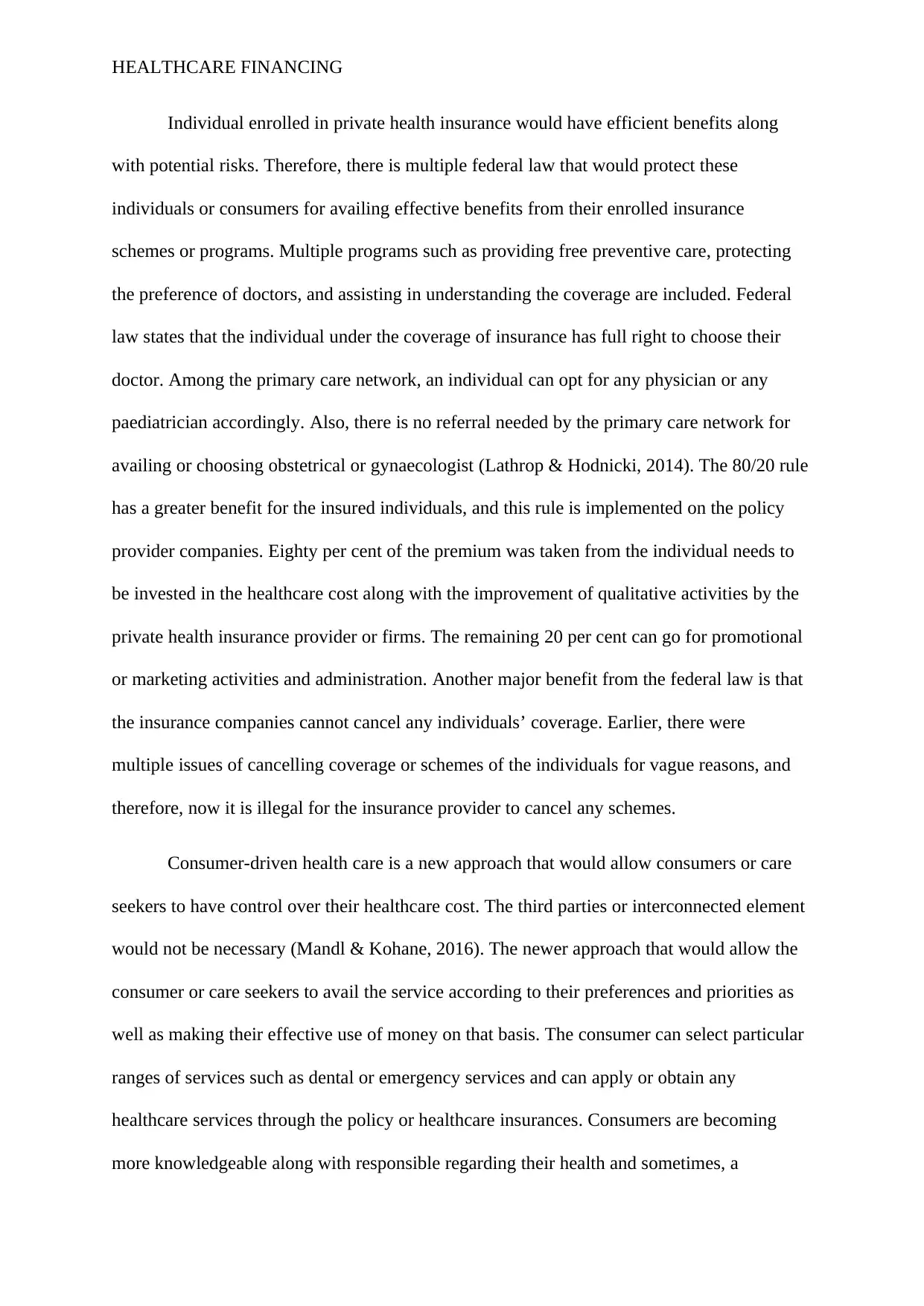
HEALTHCARE FINANCING
Individual enrolled in private health insurance would have efficient benefits along
with potential risks. Therefore, there is multiple federal law that would protect these
individuals or consumers for availing effective benefits from their enrolled insurance
schemes or programs. Multiple programs such as providing free preventive care, protecting
the preference of doctors, and assisting in understanding the coverage are included. Federal
law states that the individual under the coverage of insurance has full right to choose their
doctor. Among the primary care network, an individual can opt for any physician or any
paediatrician accordingly. Also, there is no referral needed by the primary care network for
availing or choosing obstetrical or gynaecologist (Lathrop & Hodnicki, 2014). The 80/20 rule
has a greater benefit for the insured individuals, and this rule is implemented on the policy
provider companies. Eighty per cent of the premium was taken from the individual needs to
be invested in the healthcare cost along with the improvement of qualitative activities by the
private health insurance provider or firms. The remaining 20 per cent can go for promotional
or marketing activities and administration. Another major benefit from the federal law is that
the insurance companies cannot cancel any individuals’ coverage. Earlier, there were
multiple issues of cancelling coverage or schemes of the individuals for vague reasons, and
therefore, now it is illegal for the insurance provider to cancel any schemes.
Consumer-driven health care is a new approach that would allow consumers or care
seekers to have control over their healthcare cost. The third parties or interconnected element
would not be necessary (Mandl & Kohane, 2016). The newer approach that would allow the
consumer or care seekers to avail the service according to their preferences and priorities as
well as making their effective use of money on that basis. The consumer can select particular
ranges of services such as dental or emergency services and can apply or obtain any
healthcare services through the policy or healthcare insurances. Consumers are becoming
more knowledgeable along with responsible regarding their health and sometimes, a
Individual enrolled in private health insurance would have efficient benefits along
with potential risks. Therefore, there is multiple federal law that would protect these
individuals or consumers for availing effective benefits from their enrolled insurance
schemes or programs. Multiple programs such as providing free preventive care, protecting
the preference of doctors, and assisting in understanding the coverage are included. Federal
law states that the individual under the coverage of insurance has full right to choose their
doctor. Among the primary care network, an individual can opt for any physician or any
paediatrician accordingly. Also, there is no referral needed by the primary care network for
availing or choosing obstetrical or gynaecologist (Lathrop & Hodnicki, 2014). The 80/20 rule
has a greater benefit for the insured individuals, and this rule is implemented on the policy
provider companies. Eighty per cent of the premium was taken from the individual needs to
be invested in the healthcare cost along with the improvement of qualitative activities by the
private health insurance provider or firms. The remaining 20 per cent can go for promotional
or marketing activities and administration. Another major benefit from the federal law is that
the insurance companies cannot cancel any individuals’ coverage. Earlier, there were
multiple issues of cancelling coverage or schemes of the individuals for vague reasons, and
therefore, now it is illegal for the insurance provider to cancel any schemes.
Consumer-driven health care is a new approach that would allow consumers or care
seekers to have control over their healthcare cost. The third parties or interconnected element
would not be necessary (Mandl & Kohane, 2016). The newer approach that would allow the
consumer or care seekers to avail the service according to their preferences and priorities as
well as making their effective use of money on that basis. The consumer can select particular
ranges of services such as dental or emergency services and can apply or obtain any
healthcare services through the policy or healthcare insurances. Consumers are becoming
more knowledgeable along with responsible regarding their health and sometimes, a
⊘ This is a preview!⊘
Do you want full access?
Subscribe today to unlock all pages.

Trusted by 1+ million students worldwide
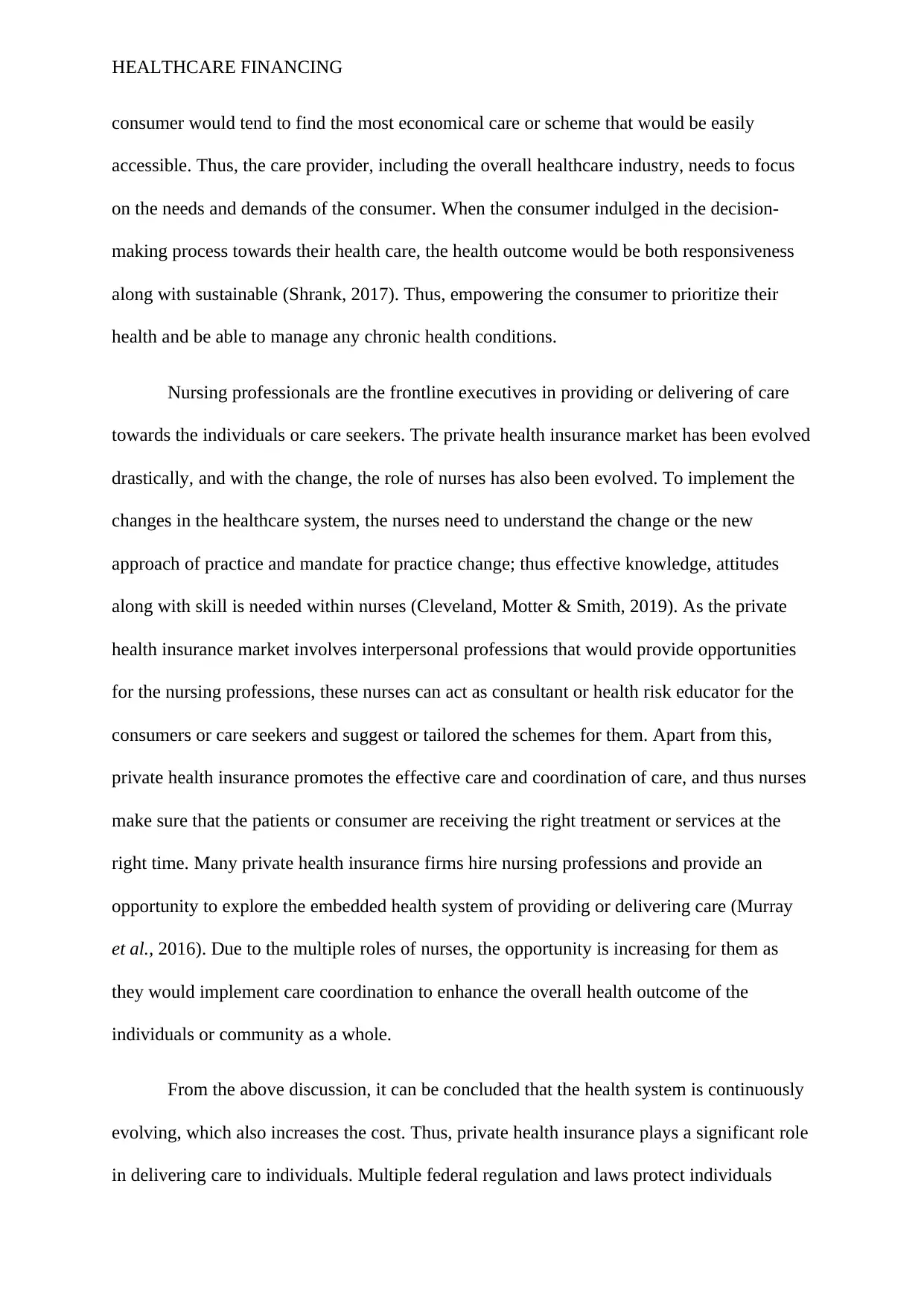
HEALTHCARE FINANCING
consumer would tend to find the most economical care or scheme that would be easily
accessible. Thus, the care provider, including the overall healthcare industry, needs to focus
on the needs and demands of the consumer. When the consumer indulged in the decision-
making process towards their health care, the health outcome would be both responsiveness
along with sustainable (Shrank, 2017). Thus, empowering the consumer to prioritize their
health and be able to manage any chronic health conditions.
Nursing professionals are the frontline executives in providing or delivering of care
towards the individuals or care seekers. The private health insurance market has been evolved
drastically, and with the change, the role of nurses has also been evolved. To implement the
changes in the healthcare system, the nurses need to understand the change or the new
approach of practice and mandate for practice change; thus effective knowledge, attitudes
along with skill is needed within nurses (Cleveland, Motter & Smith, 2019). As the private
health insurance market involves interpersonal professions that would provide opportunities
for the nursing professions, these nurses can act as consultant or health risk educator for the
consumers or care seekers and suggest or tailored the schemes for them. Apart from this,
private health insurance promotes the effective care and coordination of care, and thus nurses
make sure that the patients or consumer are receiving the right treatment or services at the
right time. Many private health insurance firms hire nursing professions and provide an
opportunity to explore the embedded health system of providing or delivering care (Murray
et al., 2016). Due to the multiple roles of nurses, the opportunity is increasing for them as
they would implement care coordination to enhance the overall health outcome of the
individuals or community as a whole.
From the above discussion, it can be concluded that the health system is continuously
evolving, which also increases the cost. Thus, private health insurance plays a significant role
in delivering care to individuals. Multiple federal regulation and laws protect individuals
consumer would tend to find the most economical care or scheme that would be easily
accessible. Thus, the care provider, including the overall healthcare industry, needs to focus
on the needs and demands of the consumer. When the consumer indulged in the decision-
making process towards their health care, the health outcome would be both responsiveness
along with sustainable (Shrank, 2017). Thus, empowering the consumer to prioritize their
health and be able to manage any chronic health conditions.
Nursing professionals are the frontline executives in providing or delivering of care
towards the individuals or care seekers. The private health insurance market has been evolved
drastically, and with the change, the role of nurses has also been evolved. To implement the
changes in the healthcare system, the nurses need to understand the change or the new
approach of practice and mandate for practice change; thus effective knowledge, attitudes
along with skill is needed within nurses (Cleveland, Motter & Smith, 2019). As the private
health insurance market involves interpersonal professions that would provide opportunities
for the nursing professions, these nurses can act as consultant or health risk educator for the
consumers or care seekers and suggest or tailored the schemes for them. Apart from this,
private health insurance promotes the effective care and coordination of care, and thus nurses
make sure that the patients or consumer are receiving the right treatment or services at the
right time. Many private health insurance firms hire nursing professions and provide an
opportunity to explore the embedded health system of providing or delivering care (Murray
et al., 2016). Due to the multiple roles of nurses, the opportunity is increasing for them as
they would implement care coordination to enhance the overall health outcome of the
individuals or community as a whole.
From the above discussion, it can be concluded that the health system is continuously
evolving, which also increases the cost. Thus, private health insurance plays a significant role
in delivering care to individuals. Multiple federal regulation and laws protect individuals
Paraphrase This Document
Need a fresh take? Get an instant paraphrase of this document with our AI Paraphraser
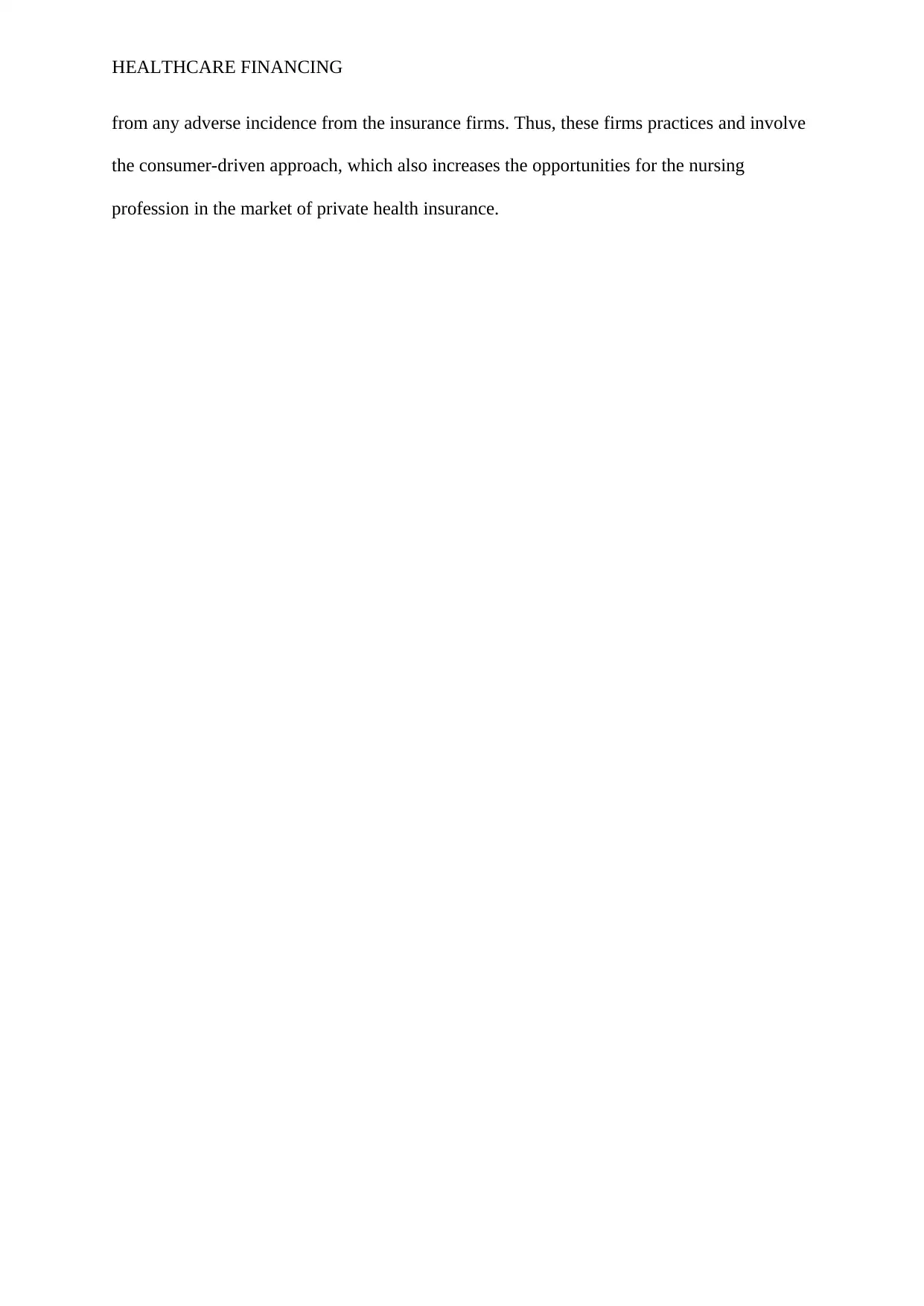
HEALTHCARE FINANCING
from any adverse incidence from the insurance firms. Thus, these firms practices and involve
the consumer-driven approach, which also increases the opportunities for the nursing
profession in the market of private health insurance.
from any adverse incidence from the insurance firms. Thus, these firms practices and involve
the consumer-driven approach, which also increases the opportunities for the nursing
profession in the market of private health insurance.
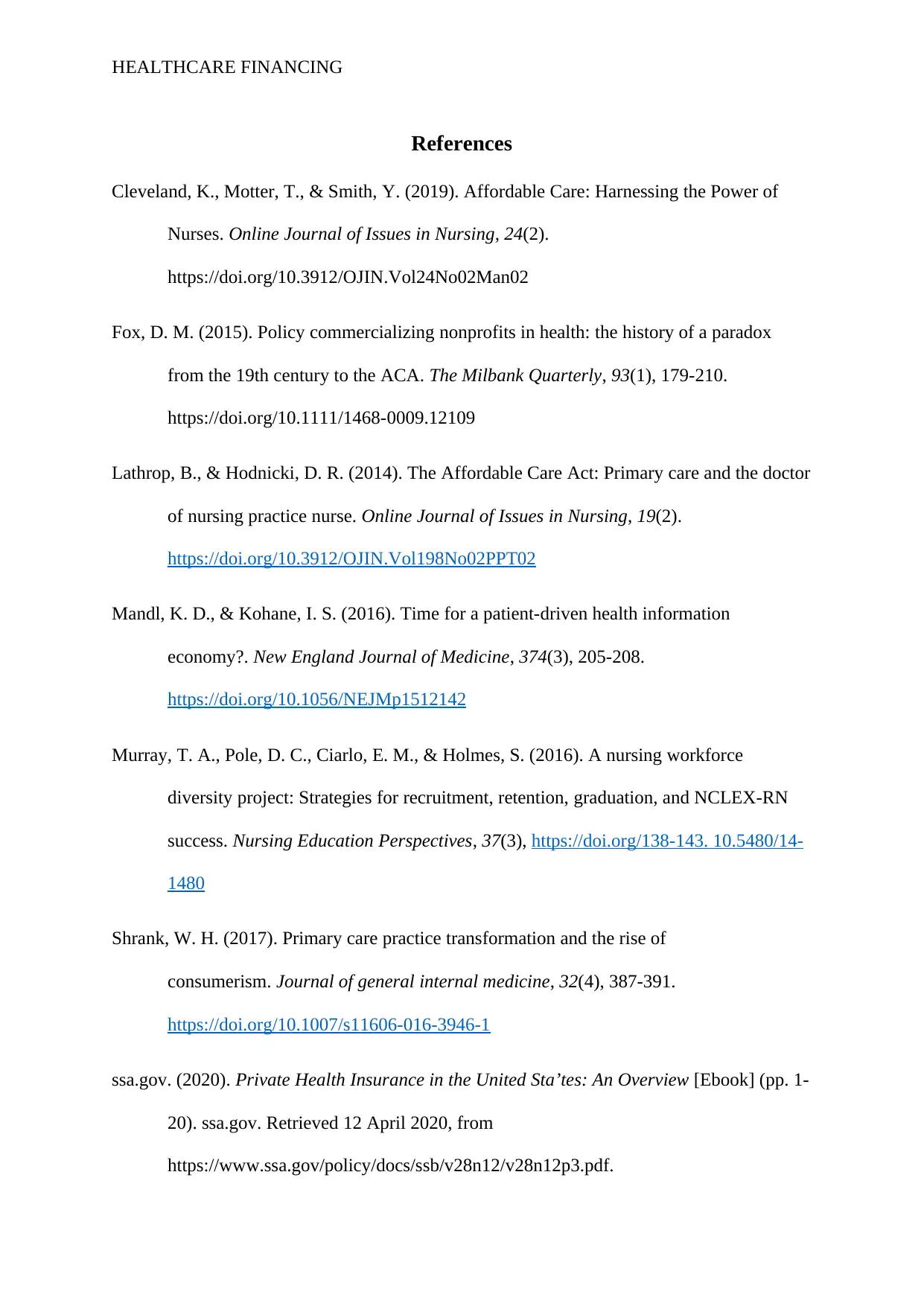
HEALTHCARE FINANCING
References
Cleveland, K., Motter, T., & Smith, Y. (2019). Affordable Care: Harnessing the Power of
Nurses. Online Journal of Issues in Nursing, 24(2).
https://doi.org/10.3912/OJIN.Vol24No02Man02
Fox, D. M. (2015). Policy commercializing nonprofits in health: the history of a paradox
from the 19th century to the ACA. The Milbank Quarterly, 93(1), 179-210.
https://doi.org/10.1111/1468-0009.12109
Lathrop, B., & Hodnicki, D. R. (2014). The Affordable Care Act: Primary care and the doctor
of nursing practice nurse. Online Journal of Issues in Nursing, 19(2).
https://doi.org/10.3912/OJIN.Vol198No02PPT02
Mandl, K. D., & Kohane, I. S. (2016). Time for a patient-driven health information
economy?. New England Journal of Medicine, 374(3), 205-208.
https://doi.org/10.1056/NEJMp1512142
Murray, T. A., Pole, D. C., Ciarlo, E. M., & Holmes, S. (2016). A nursing workforce
diversity project: Strategies for recruitment, retention, graduation, and NCLEX-RN
success. Nursing Education Perspectives, 37(3), https://doi.org/138-143. 10.5480/14-
1480
Shrank, W. H. (2017). Primary care practice transformation and the rise of
consumerism. Journal of general internal medicine, 32(4), 387-391.
https://doi.org/10.1007/s11606-016-3946-1
ssa.gov. (2020). Private Health Insurance in the United Sta’tes: An Overview [Ebook] (pp. 1-
20). ssa.gov. Retrieved 12 April 2020, from
https://www.ssa.gov/policy/docs/ssb/v28n12/v28n12p3.pdf.
References
Cleveland, K., Motter, T., & Smith, Y. (2019). Affordable Care: Harnessing the Power of
Nurses. Online Journal of Issues in Nursing, 24(2).
https://doi.org/10.3912/OJIN.Vol24No02Man02
Fox, D. M. (2015). Policy commercializing nonprofits in health: the history of a paradox
from the 19th century to the ACA. The Milbank Quarterly, 93(1), 179-210.
https://doi.org/10.1111/1468-0009.12109
Lathrop, B., & Hodnicki, D. R. (2014). The Affordable Care Act: Primary care and the doctor
of nursing practice nurse. Online Journal of Issues in Nursing, 19(2).
https://doi.org/10.3912/OJIN.Vol198No02PPT02
Mandl, K. D., & Kohane, I. S. (2016). Time for a patient-driven health information
economy?. New England Journal of Medicine, 374(3), 205-208.
https://doi.org/10.1056/NEJMp1512142
Murray, T. A., Pole, D. C., Ciarlo, E. M., & Holmes, S. (2016). A nursing workforce
diversity project: Strategies for recruitment, retention, graduation, and NCLEX-RN
success. Nursing Education Perspectives, 37(3), https://doi.org/138-143. 10.5480/14-
1480
Shrank, W. H. (2017). Primary care practice transformation and the rise of
consumerism. Journal of general internal medicine, 32(4), 387-391.
https://doi.org/10.1007/s11606-016-3946-1
ssa.gov. (2020). Private Health Insurance in the United Sta’tes: An Overview [Ebook] (pp. 1-
20). ssa.gov. Retrieved 12 April 2020, from
https://www.ssa.gov/policy/docs/ssb/v28n12/v28n12p3.pdf.
⊘ This is a preview!⊘
Do you want full access?
Subscribe today to unlock all pages.

Trusted by 1+ million students worldwide
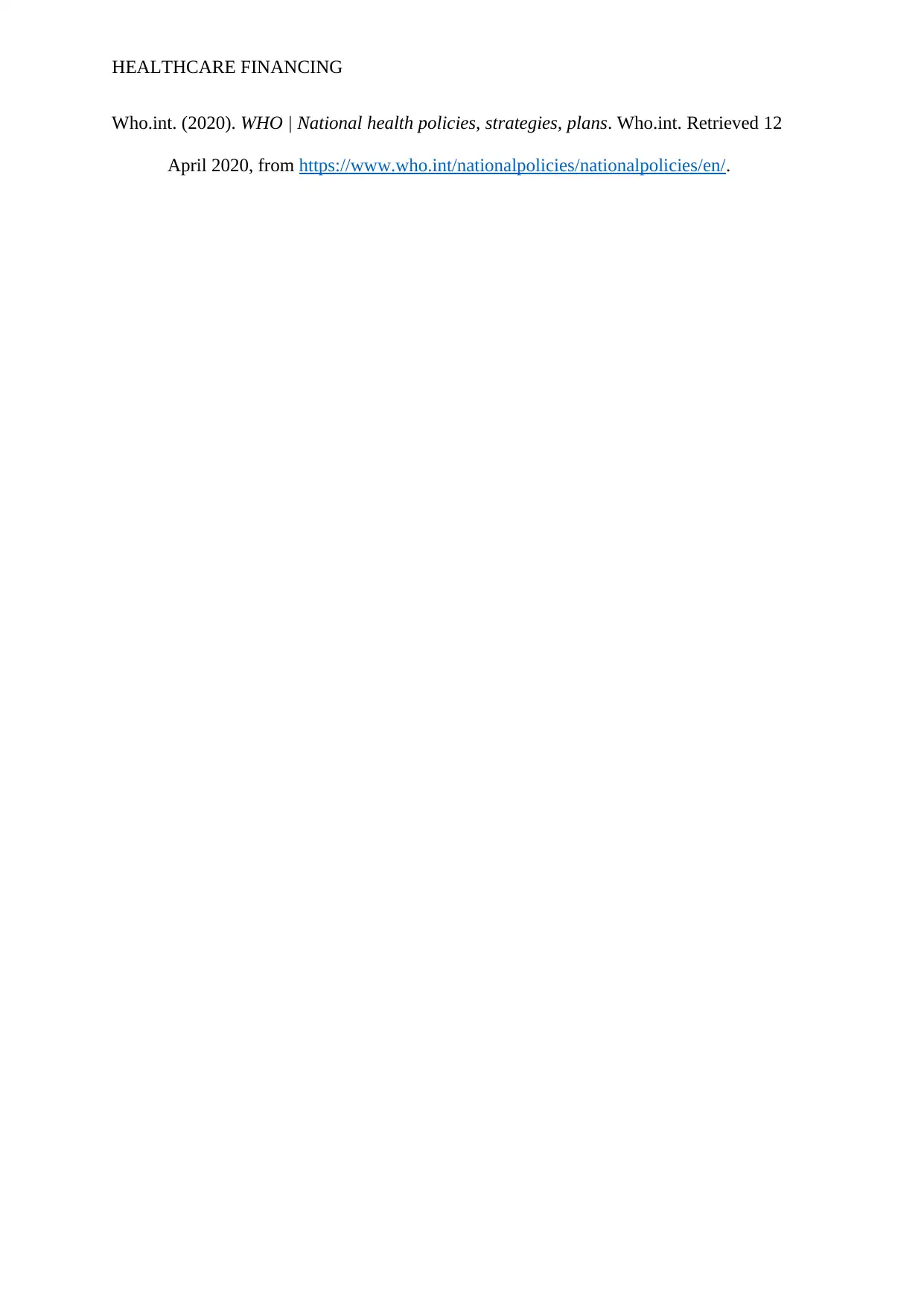
HEALTHCARE FINANCING
Who.int. (2020). WHO | National health policies, strategies, plans. Who.int. Retrieved 12
April 2020, from https://www.who.int/nationalpolicies/nationalpolicies/en/.
Who.int. (2020). WHO | National health policies, strategies, plans. Who.int. Retrieved 12
April 2020, from https://www.who.int/nationalpolicies/nationalpolicies/en/.
1 out of 7
Related Documents
Your All-in-One AI-Powered Toolkit for Academic Success.
+13062052269
info@desklib.com
Available 24*7 on WhatsApp / Email
![[object Object]](/_next/static/media/star-bottom.7253800d.svg)
Unlock your academic potential
Copyright © 2020–2025 A2Z Services. All Rights Reserved. Developed and managed by ZUCOL.





